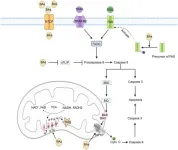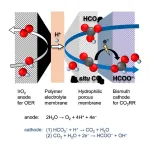(Press-News.org) ITHACA, N.Y. – New research co-led by Cornell University examines thousands of years of Arctic sled dog ancestry and reveals when and how Siberian and Alaskan sled dogs’ DNA mixed.
“There was a real concern from Siberian breeders – who were mostly racing their dogs – that they were sending out their dogs’ DNA samples for analysis, more for the context of health traits, and they were getting breed ancestry information back that said their dog was not 100% Siberian husky,” said Heather Huson, a former sled dog racer who is now associate professor of animal science at Cornell. “Many (ancestry tests) were saying the Siberian huskies were a certain percentage Alaskan husky or Alaskan sled dog.
The massive genomic survey of the Siberian husky has revealed that sled dogs descended from two distinct lineages of Arctic canids and originated in the northeastern Siberian Arctic generations earlier than previously thought. The study also showed that approximately half of all Siberian huskies bred for racing have introgression with European breeds.
Huson is co-corresponding author of “Comparative Population Genomics of Arctic Sled Dogs Reveals a Deep and Complex History,” which is under embargo until Sept. 14 in Genome Biology and Evolution. The other corresponding author is Tracy Smith, senior lecturer in the Department of Biological Sciences at the University of Maryland, Baltimore County (UMBC).
Huson said her team’s findings on genomic history are an important tool in the effort to sustain ancient lineages, such as the Siberian husky, and their unique evolutionary identity.
“It was thought that there was this one Arctic lineage,” Huson said, “but what we identified was that there are these two. One leads to our modern Siberian husky – smaller body size and stature – and the other one leads to this larger body size and to what we see now as Greenland sled dogs, and potentially the Alaskan malamutes.”
Understanding the genomic history is essential, the authors wrote, for developing effective policies and best practices for breed management.
“The more genetic diversity you have, generally the better your genetic health,” Huson said. “The slightly admixed racing Siberian huskies bring this genetic diversity to the population yet confound the original Arctic lineage which produced early Siberian huskies.”
For their research, researchers collected and analyzed DNA samples (or genomic data) from 344 dogs – mostly registered Siberian huskies but also Alaskan malamutes, Alaskan sled dogs, Chukotka sled dogs and one each of German shepherd, golden retriever, German shorthaired pointer, Samoyed and Saluki.
The researchers found that at least two distinct lineages of Arctic dogs existed in ancient Eurasia at the end of the Pleistocene era, which ended approximately 11,700 years ago. This finding pushes back significantly the origin of sled dogs in the northeast Siberian Arctic, “with humans likely intentionally selecting dogs to perform different functions,” the authors wrote. That kept concurrent breeding populations relatively reproductively isolated.
This work was supported by funding from UMBC, Neogen Genomics and the Siberian Husky Club of America.
Cornell University has dedicated television and audio studios available for media interviews.
-30-
END
Genomics reveals sled dogs’ Siberian lineage
2024-09-14
ELSE PRESS RELEASES FROM THIS DATE:
ESMO: Combination therapy reduced agitated delirium in patients with advanced cancers
2024-09-14
ABSTRACT: 1476O
BARCELONA, Spain ― Treatment with a combination of haloperidol and lorazepam reduced symptoms of agitated delirium, a common end-of-life condition for patients with advanced cancers, compared with haloperidol alone, according to a new study led by researchers at The University of Texas MD Anderson Cancer Center. The findings were presented today at the 2024 European Society for Medical Oncology (ESMO) Congress.
Agitated delirium occurs when a patient’s brain function begins to deteriorate as their cancer advances, resulting in many patients beginning to behave aggressively or abnormally. Although the use of medication ...
SOPHiA GENETICS presents ground-breaking multimodal research on AI-driven patient stratification at ESMO 2024
2024-09-14
Boston, MA and Rolle, Switzerland, September 14, 2024 – SOPHiA GENETICS (Nasdaq: SOPH), a cloud-native healthcare technology company and a leader in data-driven medicine, will unveil new research at the European Society for Medical Oncology (ESMO) 2024. The study, conducted in collaboration with AstraZeneca, leverages advanced AI-driven techniques to identify subgroups of stage IV non-small cell lung cancer (NSCLC) patients who could most benefit from the addition of tremelimumab to durvalumab and chemotherapy.
The research is a retrospective, multimodal analysis of the POSEIDON Phase 3 clinical trial (NCT03164616). This trial originally demonstrated that the combination of tremelimumab, ...
Mitochondria at the crossroads of cholestatic liver injury: Targeting novel therapeutic avenues
2024-09-14
Bile acids are essential signaling molecules derived from cholesterol metabolism in the liver and are crucial for the digestion and absorption of fats. These molecules undergo further modification in the intestines by the gut microbiome. However, disruptions in bile flow, a condition known as cholestasis, can lead to the pathological accumulation of hydrophobic BAs in the liver and bloodstream. This accumulation not only exacerbates liver damage but also induces significant disturbances in cellular processes. The review focuses on recent developments in understanding how BAs contribute to liver injury by affecting mitochondrial function, endoplasmic reticulum ...
Scientists reveal new design for cells turning carbon dioxide into a green fuel
2024-09-14
Tokyo, Japan – Researchers from Tokyo Metropolitan University have made strides forward in realizing industrial conversion of bicarbonate solution made from captured carbon to a formate solution, a green fuel. Their new electrochemical cell, with a porous membrane layer in between the electrodes, overcomes major issues suffered in reactive carbon capture (RCC) and achieves performances rivaling energy-hungry gas-fed methods. Processes like theirs directly add value to waste streams and are key to realizing net zero emissions.
Carbon capture technology ...
Paying attention to errors can improve fused remote monitoring of lakes, researchers say
2024-09-14
Lakes can tip the scales from healthy to potential environmental hazard quickly when they become eutrophic. In this state, an abundance of nutrients accelerates algae growth, which then crowd the water’s surface and block light from reaching organisms below. Without light, they can’t make oxygen and life in the water begins to die off. Luckily, researchers can monitor inland lakes for eutrophication with remote sensing technologies; however, those technologies could be adjusted to make more accurate assessments, according to researchers based in China.
The team published their evaluation of the technologies, as well as recommended paths ...
Using training model to map planted and natural forests via satellite image
2024-09-14
While planting trees may seem like an easy win to combat climate change, planted forests often encroach on natural forests, wetlands, and grasslands. This can reduce biodiversity, disturb the natural environment, and disrupt carbon and water cycling. While there has been a global increase in forest cover, it’s hard to know if this forest is the regeneration and growth of natural forests or if it is planting new trees. Accurately mapping these forests with remote sensing technology could help.
However, comprehensive maps of planted forests and natural forests are lacking even though it is possible to distinguish planted forests and natural forests on satellite images ...
Illinois Institute of Technology Architecture Programs earn National Sustainability Designation from U.S. Department of Energy
2024-09-13
CHICAGO—September 13, 2024—The College of Architecture at Illinois Institute of Technology has been awarded the prestigious Zero Energy Design Designation (ZEDD) from the United States Department of Energy (DOE) for it Bachelor of Architecture and Master of Architecture programs. This recognition highlights the college’s commitment to sustainability, carbon neutrality, and zero-energy design practices in a world of escalating extreme weather and climate change.
The ...
Rice research could make weird AI images a thing of the past
2024-09-13
HOUSTON – (Sept. 13, 2024) – Generative artificial intelligence (AI) has notoriously struggled to create consistent images, often getting details like fingers and facial symmetry wrong. Moreover, these models can completely fail when prompted to generate images at different image sizes and resolutions.
Rice University computer scientists’ new method of generating images with pre-trained diffusion models ⎯ a class of generative AI models that “learn” by adding layer after layer of random noise to the images they are trained on and then generate new images by removing the added noise ⎯ could help correct ...
NIH awards establish pandemic preparedness research network
2024-09-13
The National Institutes of Health (NIH) has established a pandemic preparedness research network to conduct research on high-priority pathogens most likely to threaten human health with the goal of developing effective vaccines and monoclonal antibodies. Currently, many of the diseases caused by these pathogens have no available vaccines or therapeutics, and investing in this research is key to preparing for potential public health crises—both in the United States and around the world. NIH’s National Institute of Allergy and Infectious Diseases (NIAID) expects to commit approximately ...
$3.9 million grant accelerates UVA professor's efforts to detect Alzheimer’s early
2024-09-13
University of Virginia professor Mathews Jacob has secured a $3.9 million grant to advance his innovative research on detecting Alzheimer’s disease in its early stages. Jacob, who specializes in electrical and computer engineering, is teaming up with researchers from the University of Iowa and the University of California-San Francisco to push the boundaries of imaging technology that tracks the brain’s metabolic changes — offering a fresh perspective on studying neurodegenerative disorders.
Their focus is on advancing magnetic resonance spectroscopic imaging (MRSI). Unlike standard MRI, which primarily highlights structural changes, ...







